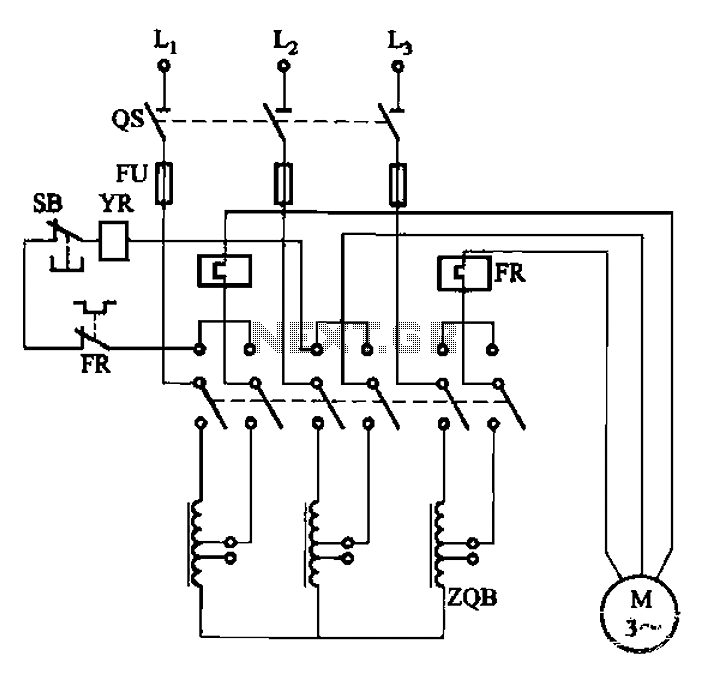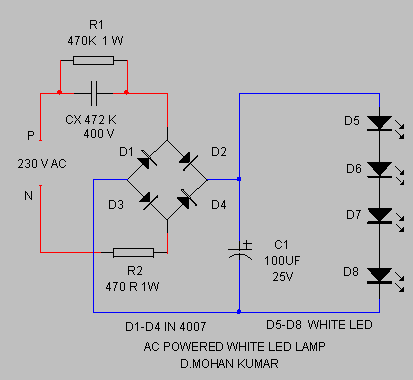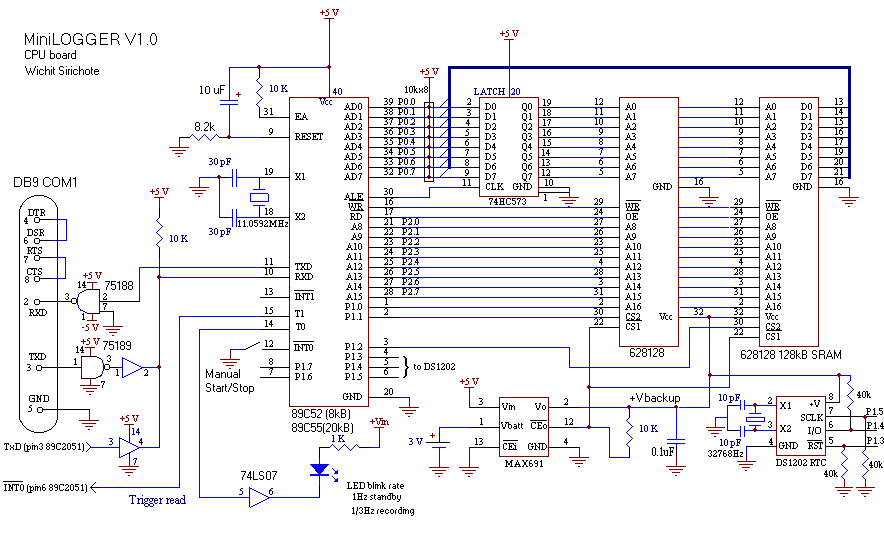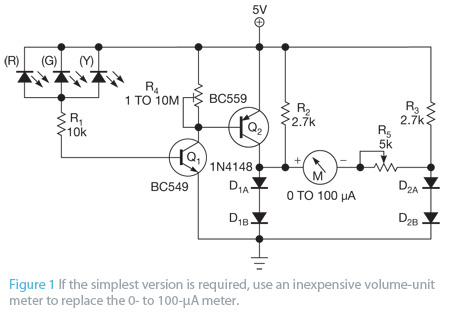
Comes with rechargeable lead-acid battery LED emergency light circuit diagram
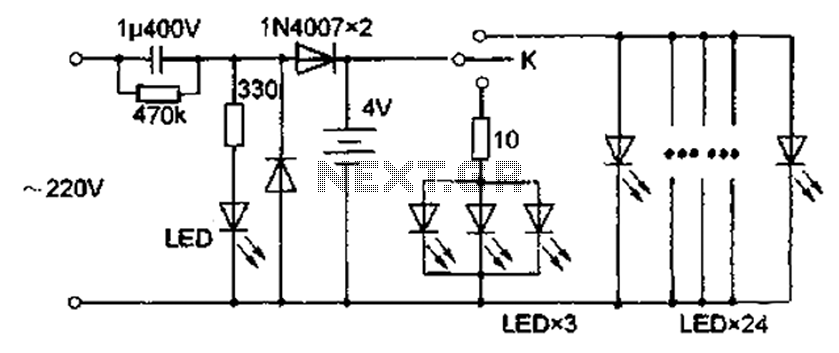
The circuit diagram depicted in Figure 5 illustrates a system for charging a lead-acid battery using 220V AC power. The circuit employs a capacitor, buck converter, and diode rectifier for this purpose. A red LED indicates the charging status. When the button switch K is activated, a three-color flashing LED emits a vibrant display of colors, enhancing nighttime visibility. When switch K is engaged, the color flashing LED is activated, followed by the illumination of 24 parallel-connected bright LEDs, which provide an impressive lighting effect. When the lead-acid battery voltage reaches 4V, the operating current measured for the lantern is approximately 60mA, while the bright LEDs draw a current of up to 600mA. This high current can lead to rapid charging but may also damage the battery's internal structure and reduce its lifespan. To mitigate this issue, a small-value current limiting resistor was incorporated into the LED string. After several tests, the operating current was eventually reduced to 320mA, with minimal change in brightness. This analysis indicates that many commercially available LED lamp circuits are overly simplistic and, despite their low cost, can result in energy waste. Reasonable improvements are necessary to maintain their economic and portable advantages while enhancing safety and reliability.
The circuit operates by converting 220V AC into a usable DC voltage suitable for charging a lead-acid battery. The capacitor serves to smooth out the rectified voltage, while the buck converter efficiently reduces the voltage to the appropriate level for charging. The diode rectifier ensures that the current flows in the correct direction, preventing damage to the battery. The inclusion of a red LED serves as a visual indicator of the charging process, providing users with immediate feedback on the operational status.
The design incorporates a button switch (K) that activates the charging circuit. Once engaged, the circuit initiates a sequence where a three-color flashing LED becomes operational, creating an attractive light display. This feature not only serves as an aesthetic enhancement but also increases visibility in low-light conditions. Following this, a series of 24 bright LEDs are illuminated in parallel, significantly boosting the overall brightness.
The initial design allowed for a high current draw of 600mA for the bright LEDs, which, while providing intense illumination, posed a risk to the longevity of the lead-acid battery. To address this, a current limiting resistor was added to the LED circuit. This adjustment effectively reduced the operating current to 320mA without a noticeable decrease in brightness, thereby balancing performance with battery health.
The analysis of existing LED lamp circuits reveals a trend toward overly simplistic designs that may compromise energy efficiency. By implementing thoughtful modifications, this circuit retains its cost-effectiveness and portability while improving safety and reliability. The enhancements ensure that the circuit not only meets user needs for illumination but also aligns with best practices in energy consumption and battery maintenance.According to kind of draw the circuit diagram shown in Figure 5, 220V AC power after the capacitor buck diode rectifier to lead-acid battery charging, the red LED for charging instructions. Close button switch K charged after use, first turn on three color flashing LED, issued fantastic vagaries of colorful light at night added some of the pleasures of life, and click the switch K is closed color flashing LED, then then only turned 24 in parallel with bright LED, due to the relatively large number of very good lighting effects. When the lead-acid battery voltage of 4V, lantern measured operating current of about 60mA, bright LED currents as high as 600 mA.
Such a large current lighting not only makes each time not too long when fully charged, and the internal structure of the battery will damage and shorten life, it is necessary to highlight the LED string into a small value current limiting resistor, after repeated selected test circuit diagram omitted 1.2 eventually reduced operating current 320mA, and the brightness change is not obvious, because the modifications are minor lights which, after the transformation. Through the above analysis found that the market for sale a variety of LED lamp circuit mostly too simple, although the price is very cheap, but the objective will result in waste of energy, and only after some reasonable improvements to retain the advantages of both its economic and portable, and effectively improve the safety and reliability.
The circuit operates by converting 220V AC into a usable DC voltage suitable for charging a lead-acid battery. The capacitor serves to smooth out the rectified voltage, while the buck converter efficiently reduces the voltage to the appropriate level for charging. The diode rectifier ensures that the current flows in the correct direction, preventing damage to the battery. The inclusion of a red LED serves as a visual indicator of the charging process, providing users with immediate feedback on the operational status.
The design incorporates a button switch (K) that activates the charging circuit. Once engaged, the circuit initiates a sequence where a three-color flashing LED becomes operational, creating an attractive light display. This feature not only serves as an aesthetic enhancement but also increases visibility in low-light conditions. Following this, a series of 24 bright LEDs are illuminated in parallel, significantly boosting the overall brightness.
The initial design allowed for a high current draw of 600mA for the bright LEDs, which, while providing intense illumination, posed a risk to the longevity of the lead-acid battery. To address this, a current limiting resistor was added to the LED circuit. This adjustment effectively reduced the operating current to 320mA without a noticeable decrease in brightness, thereby balancing performance with battery health.
The analysis of existing LED lamp circuits reveals a trend toward overly simplistic designs that may compromise energy efficiency. By implementing thoughtful modifications, this circuit retains its cost-effectiveness and portability while improving safety and reliability. The enhancements ensure that the circuit not only meets user needs for illumination but also aligns with best practices in energy consumption and battery maintenance.According to kind of draw the circuit diagram shown in Figure 5, 220V AC power after the capacitor buck diode rectifier to lead-acid battery charging, the red LED for charging instructions. Close button switch K charged after use, first turn on three color flashing LED, issued fantastic vagaries of colorful light at night added some of the pleasures of life, and click the switch K is closed color flashing LED, then then only turned 24 in parallel with bright LED, due to the relatively large number of very good lighting effects. When the lead-acid battery voltage of 4V, lantern measured operating current of about 60mA, bright LED currents as high as 600 mA.
Such a large current lighting not only makes each time not too long when fully charged, and the internal structure of the battery will damage and shorten life, it is necessary to highlight the LED string into a small value current limiting resistor, after repeated selected test circuit diagram omitted 1.2 eventually reduced operating current 320mA, and the brightness change is not obvious, because the modifications are minor lights which, after the transformation. Through the above analysis found that the market for sale a variety of LED lamp circuit mostly too simple, although the price is very cheap, but the objective will result in waste of energy, and only after some reasonable improvements to retain the advantages of both its economic and portable, and effectively improve the safety and reliability.


